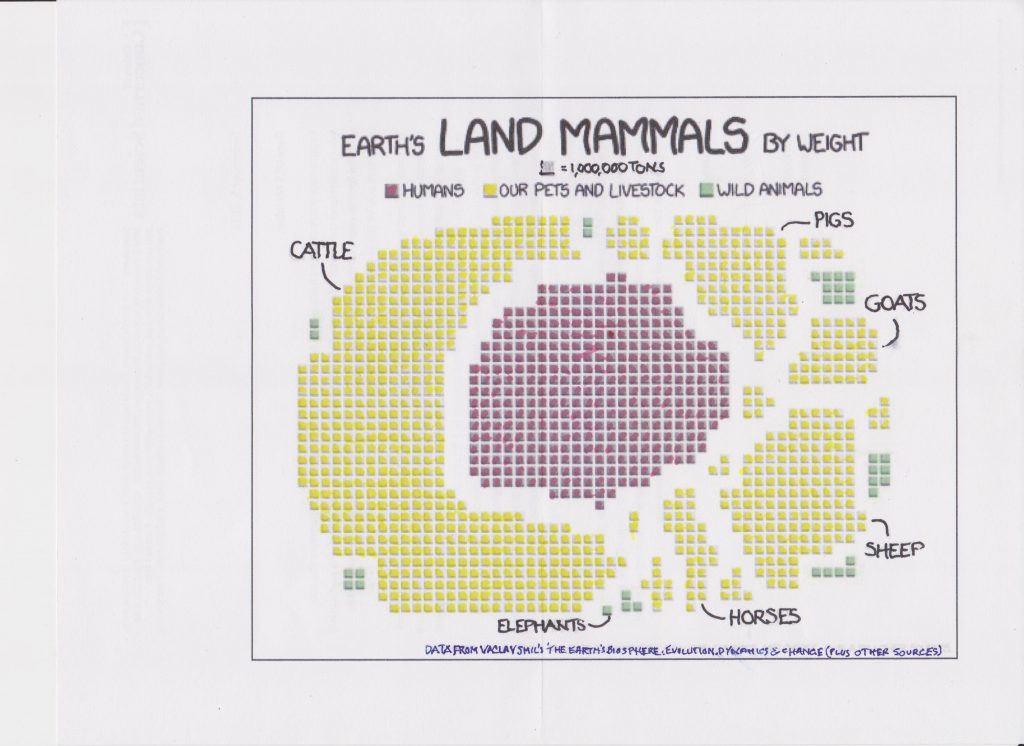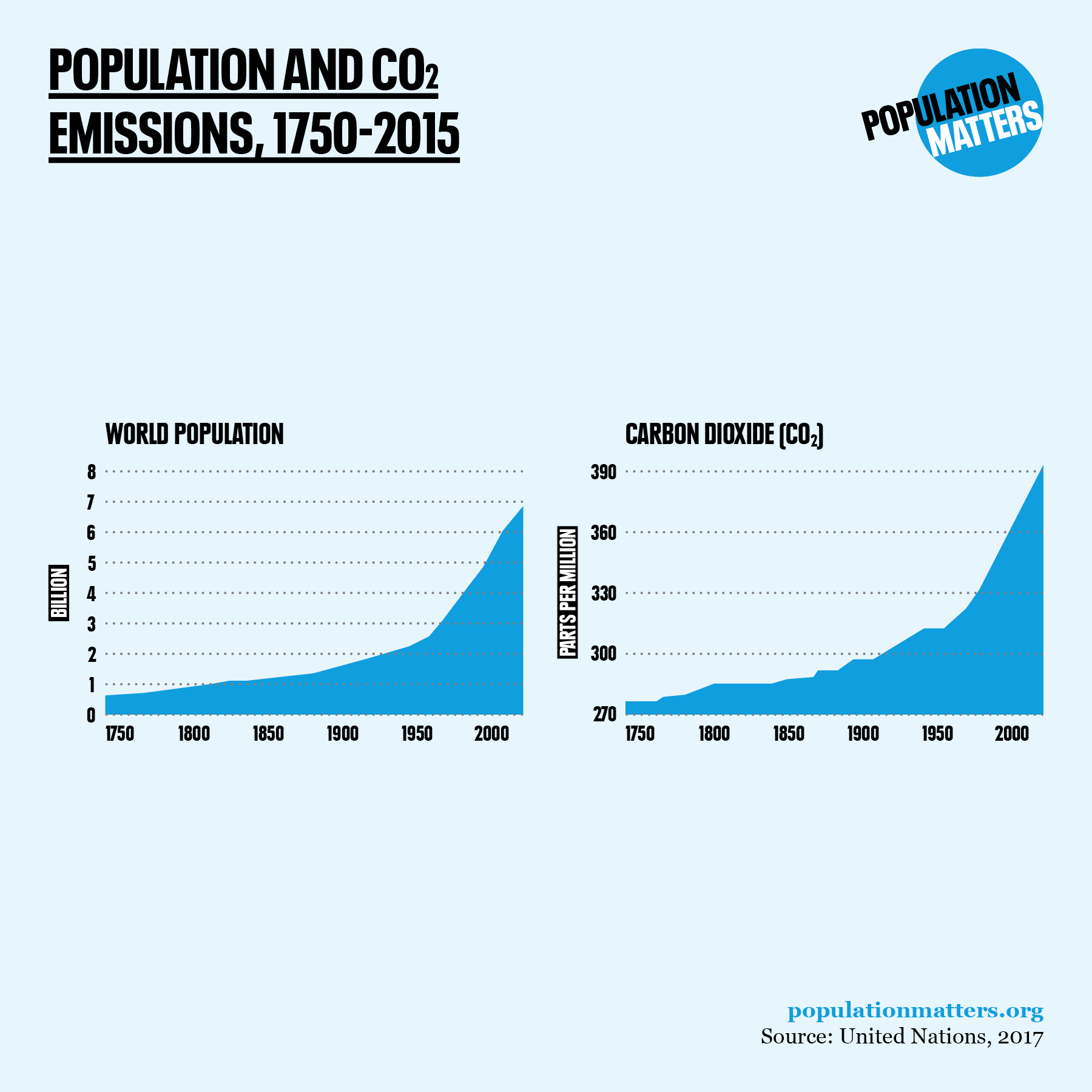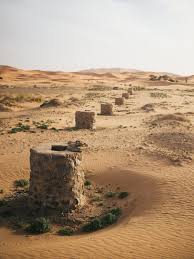This section is a justification of points in ‘The Case Simply Put’. The subjects of these points, in order, are
- Population growth figures
- The figures for total mass of land animals
- Loss of wild animals
- Extinction rates
- The area of land surface subject to human influence
- Overpopulation and conflict
- Soil degradation
- Sea level rise
- Overfishing and Marine Health
- Climate change and weather
- Dependence of agriculture on oil
- Water scarcity
- Pollution
- Overshoot
- Insects and other unconventional sources of protein
- Possible reduction of fertility
1 Population growth figures.
“The UN’s… latest median projection is a population of 9.7bn in 2050 and 10.9bn in 2100… Within its 95% certainty range, the difference in population in 2100 from the highest to lowest projection is almost 4bn people – more than half the population we have today.” (Population Matters on the graph below.)
The United Nations issues projections for future population every two years. Because many factors affect population numbers, they produce a range of estimates, with the central blue line representing the median figure. In 2017, it calculated the following high, low and median figures (in blue and red dotted in the graph above) for the middle and end of the century:
Year Low variant Median variant High variant
2050 8.9 bn. 9.8 bn. 10.5 bn.
2100 7.8 bn. 11.2bn. 16.0 bn.
Note: the low and high variant figures represent half a child less or half a child more per mother than the median variant. One child more or less every two mothers. This suggests that a reduction in world population is achievable, as the figures for the low variant indicate.
The stated figures of population growth are widely accepted. See for example the graph below, which comes from this UN site, http://esa.un.org/unpd/wpp/ and is on this page: http://esa.un.org/unpd/wpp/Graphs/Probabilistic/POP/TOT
2 Figures for total mass of land mammals
 Each square on the diagram represents a million tons. Purple squares are humanity, yellow squares are their livestock and domestic animals, green squares are wild animals.
Each square on the diagram represents a million tons. Purple squares are humanity, yellow squares are their livestock and domestic animals, green squares are wild animals.
The particular area of concern is the number of domestic animals, farmed to feed the ever-increasing number of people, especially in the developed nations. Precious forests including rain forests are cleared to grow foodstuff to feed such animals and to provide ranges. The damage to the environment is multiple, including loss of species and habitats, loss of diversity, loss of the cleansing of CO2 by forests and effects on the climate.
The figures derive from the work of Vaclav Smil, who is a Czech-Canadian scientist and policy analyst. He is Distinguished Professor Emeritus in the Faculty of Environment at the University of Manitoba in Winnipeg, Canada. See his entry in Wikipedia on https://en.wikipedia.org/wiki/Vaclav_Smil. The figures are in his book ‘The Earth’s Biosphere: Evolution, Dynamics and Change’, on which the diagram is based.
3 Loss of wildlife
The rapid loss of wildlife continues to be widely reported. For example, by 2016 wildlife numbers had shrunk by more than 50% since 1970, a period in which human numbers had doubled. This BBC report is typical: http://www.bbc.co.uk/news/science-environment-29418983
More recent reports in 2019 from Germany, Puerto Rico and the UK suggest that half of all insects may have been lost since 1970 as a result of the destruction of nature and heavy use of pesticides. The report said 40% of the 1million known species of insect are facing extinction. tinyurl.com/yynjntke
4 Extinction Rates
This article from the Center for Biological Diversity suggests that the present extinction rate is between 1000 and 10,000 times the natural background rate, and suggests we are now undergoing the sixth great extinction. See http://tinyurl.com/mz2pph3 . There have been five major extinction events in the history of the Earth, the last being at the time of the extinction of the dinosaurs.
The biologist E. O. Wilson, in his book ‘The Diversity of Life’, writes ‘…to give an idea of the dimension of the hemorrhaging, let me provide the most conservative estimate that can be reasonably based on our current knowledge of the extinction process…Even with [various] cautious parameters, selected in a biased manner to draw a maximally optimistic conclusion, the number of species doomed each year is 27,000. Each day it is 74, and each hour 3…Human activity has increased extinction between 1000 and 10,000 times over [normal background rate]… Clearly we are in the midst of one of the great extinction spasms of geological history.’ And, ‘The raging monster on the face of the land is population growth. In its presence, sustainability is but a fragile theoretical construct.’
5 The area of land surface subject to human influence. Humanity has used the best land already for farms, habitation, industry, water collection and leisure: most of what remains is ice-cap, desert, tundra or mountains.
The area affected is variously reported. An article in Geospatial World http://tinyurl.com/bd3map2w suggests 84%: however, this article from the Geological Society of America dated Dec 2012 estimates that humans have modified more than 50% of the Earth’s land surface: http://tinyurl.com/o336tco That was in 2012, a decade ago, and must already include most of the cultivable land.
6 Overpopulation and conflict. Writings that cover this subject make pretty appalling reading. For example, they cover the subject of the use of women’s wombs to out-populate a rival state, as in the Arab- Israeli conflict, (Countdown by Alan Weisman), and Iran in 1970’s in the run up to the Iran-Iraq war. It is clear that a rise in population is a threat multiplier of basic problems such as insufficient food, water, energy, housing, wealth and jobs. Without wise political guidance, both families and countries can become trapped in poverty, and stress can build.
The population in Rwanda trebled in the 1990’s becoming the most densely populated country in Africa and putting a severe strain on food supplies. The results included a severely depleted soil and diminished productivity with a shortage of jobs and, health care. The cultural situation became very competitive and bitter, with poor responses from the politicians and the genocide of one million people erupted. ” The flash points for war, just as in Rwanda, will be places where deep seated cultural or religious rivalries, high population growth, shortages of things people need or want, and insecure governments intersect. ” ( Chapter 9, Tipping Point by Barnovsky and Hadly.)
This article from The Population Institute, ‘Overpopulation May Lead to Conflict’, on tinyurl.com/oozsmqc is informative on this subject: so also is this from The Royal Institution: ‘Considering Population and War’ on tinyurl.com/o3wn8bp See also this article on pressures in Burundi, where farm sizes have shrunk from 9-12 acres in 1970 to about 1 acre now. tinyurl.com/pnekm3b
7 Soil degradation. Soil subject to modern agriculture is in rapid deterioration. An article in The Guardian on this subject is headed ‘Global Soils underpin life but future looks bleak, warns UN report’. A quarter of all the animal species on earth live beneath our feet and provide the nutrients for food. Soils also store as much carbon as all plants above ground. Scientists state that this is at least as important as climate change. It takes thousands of years for soils to form. This article is on tinyurl.com/yxfdfsju
See this Wikipedia article on ‘Soil retrogression and degradation’. on http://tinyurl.com/jyun7ot , which states ‘… when a significant destruction of the vegetation takes place (of natural origin such as an avalanche or human origin), the disturbance undergone by the ecosystem is [extreme]:…erosion is responsible for the destruction of the upper horizons of the ground, and is at the origin of a phenomenon of reversion to pioneer conditions. The phenomenon is called retrogression and can be partial or total (in this case, nothing remains beside bare rock). For example, the clearing of an inclined ground, subjected to violent rains, can lead to the complete destruction of the soil….Erosion is strongly related to human activity.’ See also tinyurl.com/dxeuu8r on desertification.
8 Sea level rise. Many major cities are in danger of flooding. The ten in greatest danger in order are Tokyo, New York, Shanghai, Kolkota, Dhaka, Osaka, Mumbai, Guangzhou, Shenzhen, Miami. London is not far behind. Other areas high on the list include the Ganges and Nile deltas, parts of the Netherlands and Lincolnshire in the UK. Many low islands like Tuvalu in the Pacific are being swamped and inhabitants are having to move elsewhere.
See also this OECD report on tinyurl.com/snqq5qo
The Wikipedia site on http://tinyurl.com/jt2ke3e, includes the statement , ‘Because of the slow inertia, long response time for parts of the climate system, it has been estimated that we are already committed to a sea-level rise of approximately 2.3 metres (7.5 ft.) for each degree Celsius of temperature rise within the next 2,000 years.’ Since temperatures have risen by one degree since pre-industrial times, it would appear that a rise of at least 2.3m is unavoidable.’ This rise is thought to be accelerating.
Transport Network Co., UK At the time of the collapse of the sea wall and railway in Dawlish, in February 2014, it was reported that sea levels were eight inches higher than at the time it was built.
An article on the site of The Climate Institute, tinyurl.com/y8pwnwgg, states, ‘During the 20th century, sea level rose about 15-20 centimeters (roughly 1.5 to 2.0 mm/year), with the rate at the end of the century greater than over the early part of the century. Satellite measurements taken over the past decade, however, indicate that the rate of increase has jumped to about 3.1 mm/year, which is significantly higher than the average rate for the 20th century.’ This article also includes information on acidification.
9 Overfishing and Marine Health The Center for Biological Diversity says this about the relationship between human population growth and the oceans: ‘The global fish crisis has become so severe, scientists and wildlife managers are calling not only for reduced consumption and better regulation, but for alleviation of poverty and “stabilization of the world’s human population” ‘. This site also draws attention to other ways we damage the oceans, from runoff of fertilizers and other pollutants, rubbish, dead zones and the ‘Pacific Gyre’ where currents have collected a massive area three times the size of France with plastics and other rubbish. (See also 13. Pollution)
The number of overfished stocks globally has tripled in half a century and today fully one third of the world’s assessed fisheries are currently pushed beyond their biological limits, according to the Food and Agriculture Organization of the UN. The damage goes beyond the marine environment: billions of people rely on fish for protein, and fishing provides the principle livelihood for millions. (WWF, https://tinyurl.com/yykp8whz )
10 Climate change and weather.
 The connection between the human activities of the increasing world population and Climate Change is well documented and widely accepted by scientists. Increased wealth leads to an increase in the numbers of cars and aircraft journeys with all their polluting potential.
The connection between the human activities of the increasing world population and Climate Change is well documented and widely accepted by scientists. Increased wealth leads to an increase in the numbers of cars and aircraft journeys with all their polluting potential.
The US National Oceanic and Atmospheric Administration, on this site, http://tinyurl.com/nl2pt5y draws the distinction between climate and weather, and makes the following point: ‘[we] have determined that human activities have become a dominant force, and are responsible for most of the warming observed over the past 50 years. Human-caused climate change has resulted primarily from changes in the amounts of greenhouse gases in the atmosphere, but also from changes in small particles (aerosols), as well as from changes in land use, for example. As climate changes, the probabilities of certain types of weather events are affected. For example, as Earth’s average temperature has increased, some weather phenomena have become more frequent and intense (e.g., heat waves and heavy downpours), while others have become less frequent and intense (e.g., extreme cold events). ‘
11 Dependence of agriculture on oil. ‘Our food system is the result of the “green revolution” which created greatly increased crop yields by using large amounts of fossil fuel energy in the form of synthetic nitrogen fertilizers, petroleum based agrochemicals, diesel powered machinery, refrigeration, irrigation and an oil dependent distribution system. This system destroys biodiversity, contributes to global climate change and degrades soil and water quality.’ (‘Implications of fossil fuel dependence for the food system’ published by Resilience.org, a programme of the Post Carbon Institute). This article is on tinurl.com/y2gmecf7
‘Increases in food production, per hectare of land, have not kept pace with increases in population, and the planet has virtually no more arable land or fresh water to spare. As a result, per-capita cropland has fallen by more than half since 1960, and per-capita production of grains, the basic food, has been falling worldwide for 20 years.’ This article from the Worldwatch Institute, is very relevant www.worldwatch.org/node/554.
An article on tinyurl.com/j9werma , is also relevant, but steers clear of population.
The book ‘Farmageddon, the true cost of cheap meat’, by Lymbery and Oakeshott, is worth reading in this connection.
12 Water scarcity
Technically, there is a sufficient amount of freshwater on a global scale. However, due to unequal distribution (exacerbated by climate change) resulting in some very wet and some very dry geographic locations, plus a sharp rise in global freshwater and demand in recent decades driven by industry, humanity is facing a water crisis. Demand is expected to outstrip supply by 40% in 2030, if current trends continue: tinyurl.com/no3cxzy
13 Pollution. Plastic pollution can afflict land, waterways and oceans. It is estimated that 1.1 to 8.8 million tonnes of plastic waste enters the ocean from coastal communities each year. Living organisms, particularly marine animals, can be harmed either by mechanical effects, such as entanglement in plastic objects, problems related to ingestion of plastic waste, or through exposure to chemicals within plastics that interfere with their physiology. Effects on humans include disruption of various hormonal mechanisms. Some researchers suggest that by 2050 there could be more plastic than fish in the oceans by weight. tinyurl.com/yyls7ed4 . Much of the debris in the Pacific Gyre is plastic.
Nutrient run-off from agriculture causes dead zones in the oceans, resulting in depletion of oxygen and consequent suffocation of all wildlife in the area. Ocean dead zones with zero oxygen have quadrupled in size since 1950, scientists have warned, while the number of very low oxygen sites near coasts have multiplied tenfold. Most sea creatures cannot survive in these zones and current trends would lead to mass extinction in the long run, risking dire consequences for the hundreds of millions of people who depend on the sea. tinyurl.com/y7wdnyk7
14 Overshoot
Each year the date on which the renewable resources for that year are used up advances. This day is called ‘Earth Overshoot Day’.

15 Insects and other unconventional sources of protein.
Producing animal meat uses valuable land which has often been cleared of forests to the detriment of both habitats and the ozone layer.( see Item 2). More people are turning to a vegetarian diet, if not a vegan one, but as our numbers rise to over 9 billion by 2050, other sources of protein are needed.
There is no reason why we shouldn’t eat insects, such as crickets. They have been on the human menu for millennia, are a valuable source of protein and can be bred on vegetable waste.. This is an article from the Food and Agriculture Organisation of the UN on the possible use of insects for food, www.fao.org/forestry/edibleinsects/en/ , and this site of a firm called Eat Grub, presents a very compelling case for eating insects: see tinyurl.com/y8kaveen
A more offputting alternative is discussed in this article, which is about the production of artificial beefsteak from human faeces: tinyurl.com/ptuvskf
There is also an academic paper on http://tinyurl.com/ha7edua about the extract of protein from sewage: you would have to pay to see the whole paper, but the introduction on the site will suffice to show that the idea is being taken seriously.
16 Possible reduction of human fertility. Reduction of human fertility is wholly possible, without coercion, and has been achieved in several countries. Policies that place the power of choice in the hands of women can have a very rapid effect where there is also Family Planning provision. See tinyurl.com/zt2lzs3 on this website, especially in reference to Bangladesh, Iran and Brazil.




